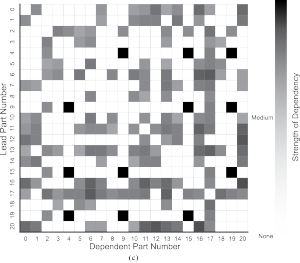Mapping the Hidden Dependencies of Engineering Systems
 Modern engineering systems are even more complex than they appear on paper.
Modern engineering systems are even more complex than they appear on paper.
Components and systems are dependent not only on each other, but on a complex web of physical and process-based inter-relationships and influences.
The number and complexity of inter-relationships between components and systems in any machine have a huge influence on cost, scheduling, and performance. For larger and more complex machines, high amounts of inter-system dependency can lead to long change-propagation chains, very high costs of design changes, and incredible complexity in structuring and control of the design process.
The key to managing this problem is in understanding of physical and design process dependencies, and the influences that components, systems, and activities have on one another. However, mapping these dependencies completely in the real world is a large and very difficult challenge.
We have developed a suite of tools that automatically map all physical and process dependencies within a machine and/or project, including both those from the physical system and the less tangible effects of any design work on other teams, other activities, and non-directly related systems. For example, when a change is made to one system, there might need to be not only changes to connected systems, but also propagating changes to unconnected systems, and re-work in analysis, planning, and manufacturing for each component in the whole chain.
When we map systems, we discover not only what should be dependent by system or module, but what is actually dependent by impact on engineering work.
By understanding the full dependency landscape, we create:
- Far higher understanding of the inter-relationship within a machine and across engineering projects and activities
- Structuring of teams and systems according to the actual work dependencies involved, rather than purely by system architecture
- Real-time and automatic analysis of work ongoing, and likely work to come
- Identification of core components and systems, data-driven system modularisation, mapping of the critical design path through any system, and many more analytics.
Recent Posts
No Recent Posts
